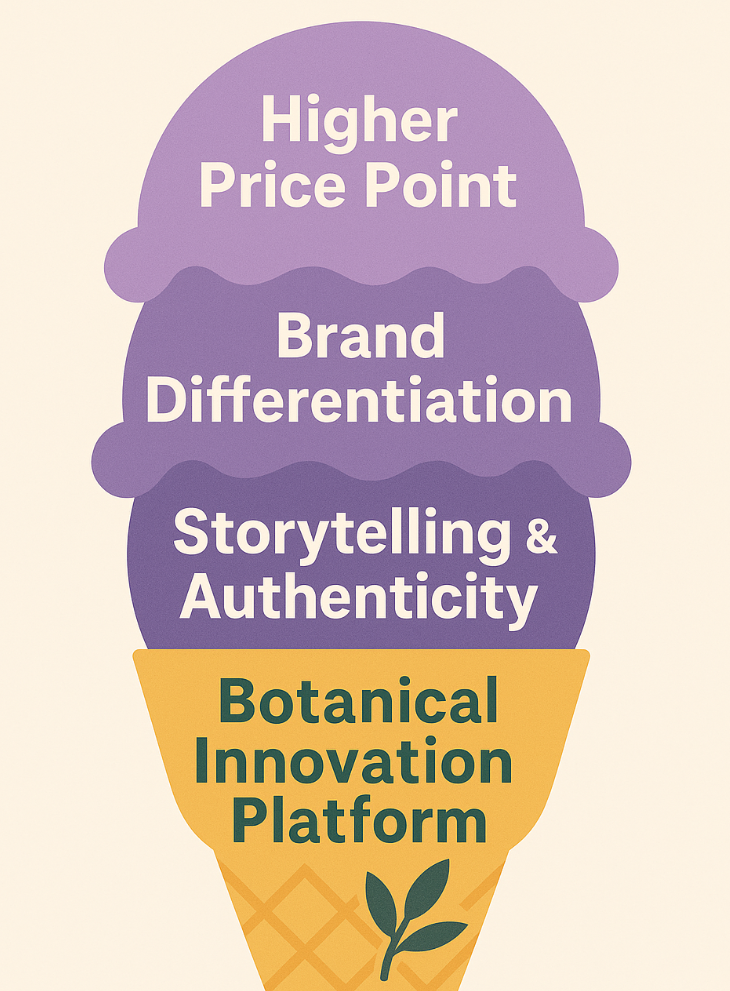
Floral and herbal ice creams have always been a thing. It looks good, tastes good, so why not? Lavender, hibiscus, rose water… they are popping up everywhere, but this time we’re seeing a real change in the way people think when it comes to food. Many of us now want natural ingredients, added benefits, and when it comes to indulgence well, wellness-focused treats.
Both big brands and small artisan shops are jumping on the trend, and already doing some trials as for example when adding functional ingredients like adaptogens to make an ice cream feel like something else than pure sugar.
It’s still a tiny part of the massive U.S. ice cream market, but these unique flavors are growing way faster than already well implemented vanilla and chocolate. People want something that feels both indulgent and good for them. We’ve already seen how spicy flavors are gaining more and more traction in ice creams as younger generations are being more adventurous about their food experiences. Plus, there’s something nostalgic and adventurous about flavors that taste like a garden.
Within the category, botanical-flavored ice creams exist more as a growing niche than a formally tracked market segment. We can get a sense of where they fit by looking at the broader landscape: traditional dairy ice cream still rules the freezer aisle, capturing over 90% of sales.
While botanical flavors don’t have their own dedicated tracking yet, their growth is happening within these established categories, suggesting there’s real consumer appetite for these garden-inspired treats even if they’re not big enough to warrant their own data slice.

Americans are falling for floral flavors. New product launches including these botanical tastes have jumped 5.6% globally over five years, with hibiscus leading the charge in dairy products and ice creams.
People are also searching more for sorbet, which makes sense given its 9.2% sales bump last year, while frozen yogurt searches are dropping along with its declining sales. The trend is clear: we’re gravitating toward fruit and flower-based frozen desserts that feel both trendy and healthier than traditional options.
For ice cream makers, botanical flavors are pure strategic gold. They are a way to shake things up and stand out in a crowded freezer case by using our love for natural ingredients, while adding good backstory to it. In an industry built on indulgence, these garden-inspired treats create a premium sweet spot that lets brands charge more while boosting their quality reputation.
Noona’s Ice Cream releasing a Yuzu Blossom already back in 2016; that’s positioning. They’re telling sophisticated adults, “We get your taste for the finer things.” Meanwhile, artisan brands use botanicals to flex their culinary chops and prove their authenticity. It’s central to this whole “craft ice cream” vibe that food lovers are looking for.

|
Brand (U.S.) |
Notable Botanical Flavors |
Functional Add-ins |
Positioning |
|
Jeni’s Splendid Ice Creams (artisan) |
Wildberry Lavender (signature floral berry) |
None, focus is on natural ingredients (no artificial flavors) |
Super-premium artisanal brand; culinary-inspired flavors and high butterfat Emphasizes creative pairings and sourcing (real berries, lavender extract). |
|
Salt & Straw (scoop shop & retail pints) |
Flower series with Jasmine, Rose Water, Rhubarb, Hibiscus, Marigold |
Occasionally spirits or tinctures in recipes |
Innovative “farm-to-cone” ethos . Known for rotating monthly menus and storytelling flavors (see Persian inspired rose and pistachio) |
|
Frankie & Jo’s (plantbased specialist) |
Chocolate Tahini Supercookie: chocolate ice cream with tahini & ashwagandha |
Adaptogens & superfoods |
100% vegan, innovative flavors focused on wellness. All-natural, gluten-free, and refined sugar-free positioning. |
Working with botanical ingredients is like walking a tightrope; they can be absolutely magical when you reach the good balance, but go just a smidge too far and suddenly your lavender drink tastes like you’re sipping on soap or potpourri.
Let’s use rose or lavender as examples. A delicate touch gives you this beautiful, almost ethereal flavor that makes people stop and say “wow, what IS that?” But add even a tiny bit too much and you’ve crossed into perfume territory where Johnny Depp starts showing up in your commercial. Nobody wants to feel like they’re drinking their grandmother’s bathroom air freshener.
The secret sauce? Don’t let botanicals fly solo. They need friends. Lavender loves hanging out with citrus profiles, so why not try a Yuzu Lavender or Lavender with sweet honey? A lemon would cut through potential soapiness while the honey smooths everything out.
Smart flavor developers know this well. They’ll tell you that the magic happens when you find those perfect partnerships that bring out the best in each ingredient without letting any one flavor boss the others around.
It’s part art, part science, and a whole lot of patience.
Now keep in mind, adding liquids like botanical teas or a fancy gin for your rosemary ice cream can completely mess with your freezing process. Too much gin and your “ice cream” becomes expensive soup. That’s why most alcohol flavors stick to around 0.5% alcohol or fake it with alcohol-flavored sugars.
Citrus and certain herbs are equally troublemakers. All that acidity can turn your cream into cottage cheese or make your sorbet feel like you’re eating flavored ice chips. The pros fight back with stabilizers like guar gum and pectin.
And if you’re going full fancy with actual flower petals, you want to make sure they’re not going to turn into chewy hockey pucks when frozen. You’d be better off grinding them up or turning them into candies.
Intro: What’s the scoop on frozen dessert trends? Sorbets surge, plant-based ice-creams slump, SPINS finds